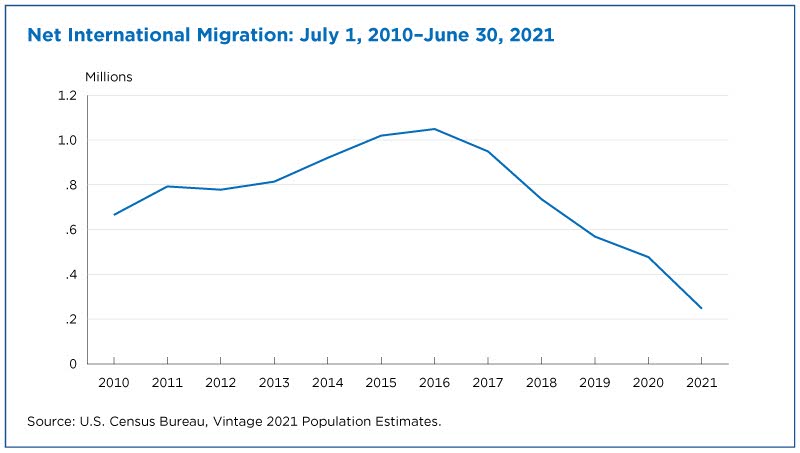Much has been made about the labor force participation rate, or the percentage of Americans over 16 who are working or actively looking for work — and for good cause, given the number of unfilled vacancies at U.S. firms. If fewer Americans are working, it is going to be harder for firms to staff all of their openings. Currently, 62.2% of adult Americans are working or looking for work. This compares with a historical average of 63.9% in 2019. With 259 million adult Americans, this 1.7 percentage point decrease in the labor force participation rate translates to a missing 4.4 million workers. And the narrative to date has primarily focused on how many Americans made changes following the COVID-19 pandemic (in response to lockdowns, layoffs, health concerns or care responsibilities) and the sizable fraction of these Americans who are still sitting on the sidelines. Given the steady drumbeat of news about how firms are unable to fill all their positions, there is much interest in how and when we expect these workers to return to the labor force. So, when can we expect them to join the labor pool?
No one can predict the labor market, and much of what is to come will depend on the evolution of the COVID-19 virus and how well the Federal Reserve can bring down inflation without pushing the economy into a recession. If we dig more into the data, however, there is reason to believe that the labor force participation has already recovered and that incremental gains may be modest. The issue is that population demographics have changed over these past years in a way that will depress labor force participation rates.
Demographics, Demographics, Demographics
Labor force participation rates decline mechanically as the population ages. Older Americans are less likely to be working but are included in these statistics. And with the large baby boomer generation entering retirement years, the American population is shifting older. In 2018, 15.81% of Americans were over 65 years of age. In 2020, that increased to 16.63%. This pattern is not new: The labor force participation rate declined by 4 percentage points between 2000 and 2017. While the Great Recession played a role, research has shown that more than half of this decline can be attributed to changing demographics.1
A better way to look at our situation now is to look at labor force participation over prime age workers, where prime age workers are defined as between the ages of 25 and 54. As of April, 82.4 percent of prime age Americans are employed or looking for work. In April 2019, 82.3 percent of prime age Americans were employed or looking for work. Yes — the current labor force participation among prime age workers is actually higher, as compared to two years ago. As much as we have made of the low labor force participation rate in the current economy, if we look just at prime age workers, we are back to where we were in 2019 and above the historical average over the prior 10 years. The one exception is 2020, when the labor force participation rate of prime age workers briefly hit 83.1.
Will Older Workers Be Tempted Back to the Workforce?
So getting back to my first question, what has to happen for the U.S. labor pool to grow? It is possible the prime age labor force participation rate can increase. The rate was higher in late 2019 and early 2020, but we are already well above recent historical averages. It does not appear there is a large number of prime age workers whom we would expect to see in the labor force but are instead sitting on the sidelines. However, rising wages and inflation may draw more prime age Americans into the labor force.
Demographic trends are unlikely to shift anytime soon, suggesting we should expect lower labor force participation rates going forward. Workers 55 years of age or older will continue to represent a larger fraction of the U.S. population. It is also interesting to note that there has been a stark decline in labor force participation among workers 55 years of age or older following the COVID-19 pandemic, which has not since been reversed. In effect, we are seeing a double whammy here. More Americans are now part of an older cohort that is less likely to be in the labor force traditionally, and labor force participation among this age group is depressed as compared with historical norms.
Will older Americans rejoin the labor force? This is the big question. Have these workers retired and permanently exited the workforce or will the hot job market tempt them back? In 2021, 50.3% of Americans 55 or older reported that they were retired, compared with 48.1% in 2019.2 This trend is also supported by rising asset prices, which make it easier for Americans to afford to stop working at a younger age. Given COVID-19’s disproportionate risk to older Americans, health fears could also be leading to lower workforce participation among this age group. It is interesting to note, however, that there was a significant uptick in labor force participation rates among workers 55 or older in January 2022, during the surge of the omicron variant. Overall, labor force participation among this cohort is still significantly below historical averages, suggesting there is considerable room for increased employment.
Finally, the U.S. labor pool is calculated as the fraction of the population that is working times the overall population. As such, declines in net migration also reduce the size of the labor force. Net international migration between July 2020 and July 2021 was 247,000, compared with 2015 and 2016, when the U.S. population added over 1 million through migration. Any increase in net migration will expand the U.S. labor supply.

1 Kreuger. 2017. Where have all the workers gone? An inquiry into the decline of the US labor force participation rate. Brookings Papers on Economics Activity. Pages 1-59.
2 See https://www.pewresearch.org/fact-tank/2021/11/04/amid-the-pandemic-a-rising-share-of-older-u-s-adults-are-now-retired/ for more information.

Should We Expect the U.S. Labor Force to Grow Dramatically?